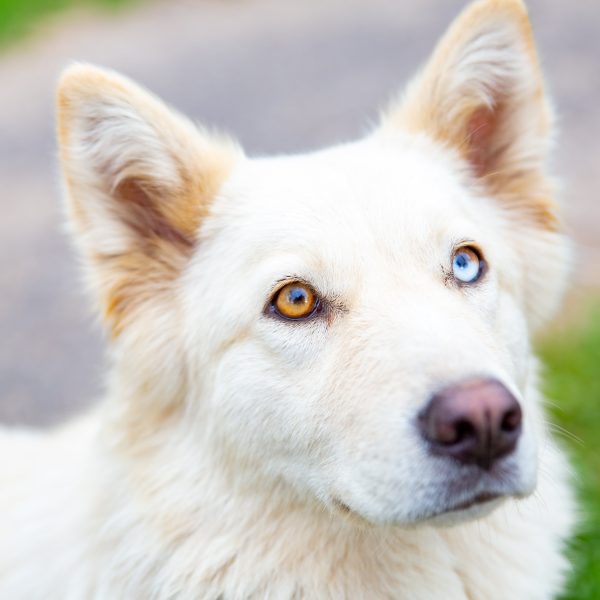What to Know About Heterochromia in Dogs

While it feels like a unique trait, a dog that has two different-colored eyes is actually not that uncommon. This trait is called heterochromia. One eye may be one color while the other may be blue or light blue. Here’s what to know about heterochromia in dogs:
What is Heterochromia?
Heterochromia is a scientific term for two different-colored eyes. This is caused by a lack of melanin pigmentation in the eye. Heterochromia can appear in dogs, cats, horses, and even sometimes people. When a dog has heterochromia, this lack of melanin can cause one eye to appear blue or bluish-white.
There are two kinds of heterochromia: hereditary and acquired. Hereditary means it is inherited genetically and acquired means it may develop later on in life. Hereditary heterochromia is often nothing to be concerned about.
However, if heterochromia is acquired later in life, it is often due to an injury or disease. If you notice that your dog’s eyes are changing color, you should schedule an appointment with your veterinarian so they can check out your dog.
3 Types of Inherited Heterochromia in Dogs
Inherited or genetic heterochromia can present in three different ways.
1. Complete Heterochromia
Complete heterochromia, otherwise called “heterochromia iridum” means the irises are two different colors. Dogs with complete heterochromia or sometimes called “bi-eyed.”
2. Sectoral Heterochromia
The second type, “sectoral heterochromia”, means there are two different colors in the same iris. This is called “parti-eyed.” These variations in colors might include flex, marbling, and geometric splits. Geometric splits are when segments of the iris are different colors.
3. Central Heterochromia
Central heterochromia is the third type of heterochromia in dogs. This means different colors within the iris create a spiked or halo effect.
Causes of Acquired Heterochromia
When a dog presents with acquired heterochromia, it is often due to an injury or disease to the eye. A hard blow to the head, eye inflammation, or other types of eye injuries or eye problems in dogs can cause acquired heterochromia to present.
Even certain medications may cause acquired heterochromia. If your dog is exhibiting eye pain, call your vet immediately. Eye pain is just one of the symptoms you should never ignore in your dog.
Are Dogs With Heterochromia At Risk For Other Health Problems?
Dogs with inherited heterochromia often have good eyesight and hearing, contrary to popular belief. They are also not usually at a higher risk for other problems than dogs with the same colored eyes.
The exception to this rule is dogs with a merle pattern. The merle pattern gene has been linked to deafness and a few severe eye diseases. This gene is also linked to albinism in dogs and dogs with this pattern should be genetically tested, especially if breeding for the merle pattern is intended.
If you notice that your dog’s eyes are changing color over time, they should be evaluated by your veterinarian. Your vet will want to determine the underlying cause of the acquired heterochromia and start treatment if necessary.
In What Dog Breeds is Heterochromia Most Common?
Just like certain breeds are predisposed to inherit albinism or other conditions, so are certain breeds more likely to inherit heterochromia. These breeds include but are not limited to:
This is just a brief overview of what to know about heterochromia in dogs. Most of the time, heterochromia is a unique feature that your dog might have inherited. However, as mentioned above, if you notice changes in your dog’s eyes, be in touch with your vet.
